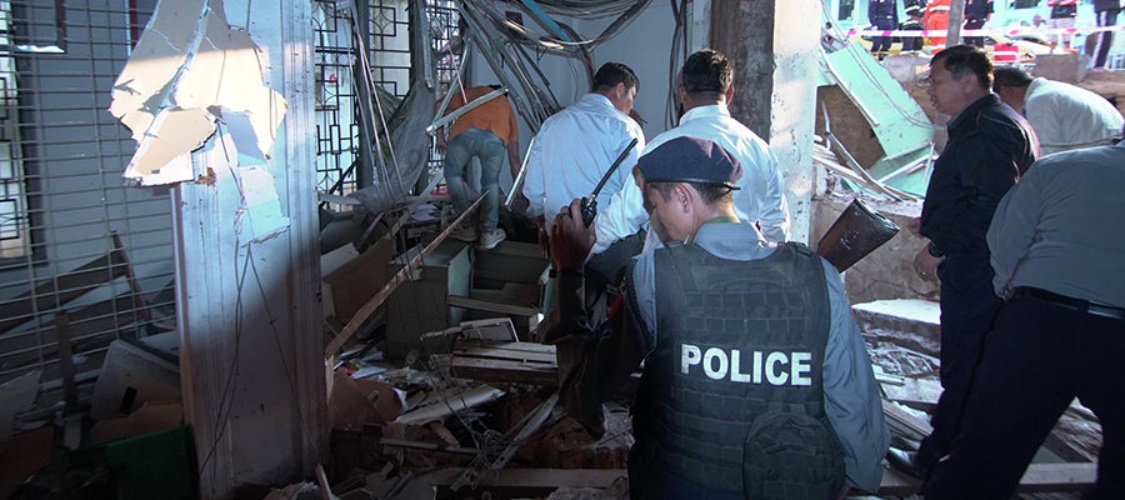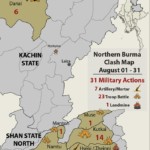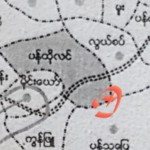By Lawi Weng / The Irrawaddy | February 22, 2018
Local residents in Lashio reported that the situation there had stabilized Thursday following a bomb blast at a Yoma Bank branch on Wednesday that killed two people and wounded 21, though many residents expressed concerns about security as authorities conducted checks and patrols around the town in northern Shan State.
A witness to the blast, U Kyaw Aung, told The Irrawaddy, “Just after I parked my car, I was walking toward the public market when I heard a loud blast. The windows from the bank were blown out and there was glass all over the street. The windows of my car were also shattered.”
The market was busy as usual on Thursday, he said, adding there was no sign of tightened security inside the town. However, local residents reported that authorities were checking vehicles on roads leading in and out of the town, and had tightened security in the surrounding areas.
Lashio police said Thursday that the bomb appeared to be a locally made device.
Two women were killed in the blast. Of the 21 people injured, four men and two women remained in hospital Thursday, said Lashio police officer Colonel U San Win.
According to U San Win, the bomb had been placed against a wall of the bank building. When it detonated, it partially destroyed the wall, damaging the interior of the bank and causing casualties, he said.
Both Yoma Bank and Ayeyarwady Bank were struck by the blast, but the latter suffered only minor damage.
While the situation appeared to have stabilized, some local people said they didn’t feel secure in the town and were thinking about leaving in case other blasts occurred.
Authorities said they were investigating who was responsible for the bombing, but had yet to release any information on possible suspects, saying only that they were preparing charges.
The Myanmar Army (Tatmadaw) said a month ago it had distributed flyers warning local residents that the Kachin Independence Army and Ta’ang National Liberation Army were planning a bombing campaign against the city. Public places, government buildings and bus stations were being targeted, and the KIA and TNLA had infiltrated about 10 and 20 people into the town, respectively, the Army said.
Maj. Khaing Zaw Win from the Military Security Department told The New York Times in a report published Wednesday that the Tatmadaw had received information that the two armed groups had prepared bombs a long time ago, prompting the distribution of the fliers a month ago.
TNLA spokesman Colonel Tar Aike Kyaw denied the accusation when contacted by The Irrawaddy.
“It is not our policy to bomb public properties. We were not involved in it,” Col. Tar Aike Kyaw said.
He said the Tatmadaw fliers referred to by Maj. Khaing Zaw Win were distributed last year, not a month ago. The Tatmadaw was using Wednesday’s blast to revive its claims against the armed groups on social media, he said.
Police and Army personnel were patrolling around the town in vehicles and army tanks night and day to maintain security in Lashio. Some residents were asking how the KIA and TNLA could have managed to stage an attack on a bank.
The TNLA spokesmen echoed these comments, saying, “They
“It could be a personal dispute or it could be politically motivated, with the aim of threatening the people in the town,” Col. Tar Aike Kyaw said.
The Army and the government typically point the finger at rebels when there is a bomb blast in the country. However, neither have issued any official statement regarding who is to blame for the bombing. Meanwhile, the Army and police investigation is ongoing.
Local residents offered various theories on the bomb blast. One resident said that because the conflict in Arakan had quietened down recently, the Tatmadaw may be planning to launch a big military offensive in northern Shan State. Therefore, they planted the bomb to make it look like the work of the rebels, according to this theory.
Others believed the bombing was related to a recent drug raid in Kutkai in which Army and police seized nearly 10 billion kyat worth of illegal drugs.
Some locals even suggested Yoma Bank was bombed because it failed to pay taxes to the rebel groups. Other Lashio sources downplayed this idea, saying all banks based in northern Shan have to pay taxes to rebels, with the exception of Myanmar Economic Bank.
Lashio is home to communities of Shan, Palaung, Wa, Kokang, Kachin and Burmese. Just a four-hour drive from the town of Muse on the Chinese border, Lashio’s economy has boomed in recent years due to cross-border trade with China.
The Myanmar government and Army have entered into a peace process with 10 ethnic armed groups, most of them from the south of the country. At least seven other armed groups, who are members of the Northern Alliance based in northern Shan, have declined to sign the Nationwide Ceasefire Agreement.
The KIA, TNLA, Arakan Army, Myanmar National Democratic Alliance Army and Shan State Progress Party are all members of the Northern Alliance. They are all based in northern Shan, and often engage in fighting against the Tatmadaw.
This article originally appeared on The Irrawaddy on February 22, 2018.







